LU-8005 - The QUV Compared 10 Enclosed Carbon Arc
Technical Bulletins
Posted 2023
Last Updated 2023
LU-8005
Weathering is an important cause of damage to plastics, textiles, coatings, and other organic materials. Accelerated weathering testers are used to simulate this damage for research and development, quality control, and material certification. Two widely used accelerated testers are the QUV (ASTM G-53) and the Enclosed Carbon Arc (ASTM G-23). The testers differ in several important areas: light spectrum, method of moisture simulation, required maintenance, price and operating cost.
EMISSION SPECTRA
Carbon arcs were designed on the idea that, to simulate sunlight, it is necessary to reproduce the entire spectrum of sunlight. The QUV uses a different approach. QUV lamps do not attempt to reproduce sunlight itself, just the damaging effects of sunlight. This approach is effective because short wavelength UV causes almost all of the damage to durable materials exposed outdoors. Consequently, QUV lamps confine their primary emission to the UV portion of the spectrum. This results in different spectra from the carbon arc and, usually, different test results. To understand the difference between the carbon arc and the QUV, its necessary to first look at the spectrum of sunlight.

THE SUNLIGHT SPECTRUM
The electromagnetic energy from sunlight is normally divided into ultraviolet light, visible light, and infrared energy. Figure 1 shows the spectral power distribution (SPD) of noon midsummer sunlight. Infrared energy (not shown) consists of wavelengths longer than the visible red wavelengths and starts above about 760 nanometers (nm). Visible light is defined as radiation between 400 and 760 nm. Ultraviolet light consists of radiation below 400 nm. The International Commission on Illumination (CIE) further subdivides the UV portion of the spectrum into UV-A, UV-B and UV-C as shown in Figure 1.
IMPORTANCE OF SHORT WAVELENGTH CUT-OFF
Photochemical degradation is caused by photons of light breaking chemical bonds. For each type of chemical bond there is a critical threshold wavelength of light with enough energy to cause a reaction. Light of any wavelength shorter than the threshold can break the bond, but longer wavelengths of light cannot break it-regardless of their intensity (brightness). Therefore, the short wavelength cut-off of a light source is of critical importance. For example, if a particular polymer is only sensitive to UV light below 295 nm (the solar cutoff point), it will never experience photochemical deterioration outdoors. If the same polymer is exposed to a laboratory light source that has a spectral cut-off of 280 nm, it will deteriorate. Although light sources that produce shorter wavelengths produce faster tests, there's a possibility of anomalous results if a tester has a wavelength cut-off too far below that of the material's end use environment.
Conversely, if a light source is deficient in short wavelength UV, it may not have any effect on a material that will deteriorate upon exposure to sunlight. Or the material may not degrade in the same manner (or to the same degree) as in actual service.
ENCLOSED CARBON ARC SPECTRA
The enclosed carbon arc has been used as a solar simulator in accelerated weathering and lightfastness testers since 1918. Many ASTM and Federal Test Methods still specify its use. When the light output of this apparatus is compared to sunlight, some deficiencies become evident. Figure 2 shows the UV spectral power distribution (SPD) of summer sunlight compared to the enclosed carbon arc. The UV output of the enclosed carbon arc primarily consists of two very large spikes of energy, with a very small amount of output below 350 nm.

Since the shortest UV wavelengths are the most damaging, the enclosed carbon arc gives very slow tests on most materials and poor correlation on materials sensitive to short wavelength UV. Figure 3 shows the same SPD comparison graphed on a different vertical scale to include all of the output from the spikes.

Carbon rods in the carbon arc have to be replaced daily. The emission spectrum may vary from carbon to carbon. This can create significant variability in results from short term tests, and it mayor may not create problems for exposures that last long enough to average out the differences in carbon output.
QUV LAMP SPECTRA
There are different types of QUV lamps, with different spectra, for different exposure applications. For further information see Q-Panel Bulletin LU-0816, Choice of Lamps.
UV-8 Lamps
UV-B lamps are the most widely used QUV lamps. They have demonstrated good correlation to outdoor exposures for the gloss retention in coatings and for the material integrity of plastics. However their short wavelength output below the solar cut-off can occasionally cause anomalous results, especially for color retention of plastics and textile materials. The QUV, with UV-B lamps, will generally give significantly faster test results than an enclosed carbon arc.
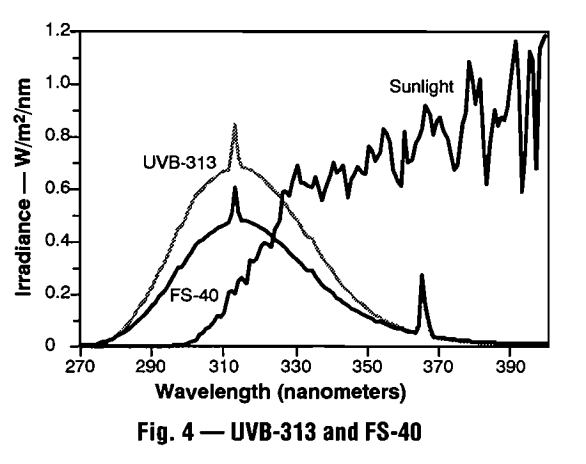
UVA Lamps
UV-A lamps were developed to enhance the correlation between QUV and outdoor testing. They usually give slower results than the UV-B, but are more realistic. UV-A lamps have been successfully used for testing plastics, textiles and coatings.
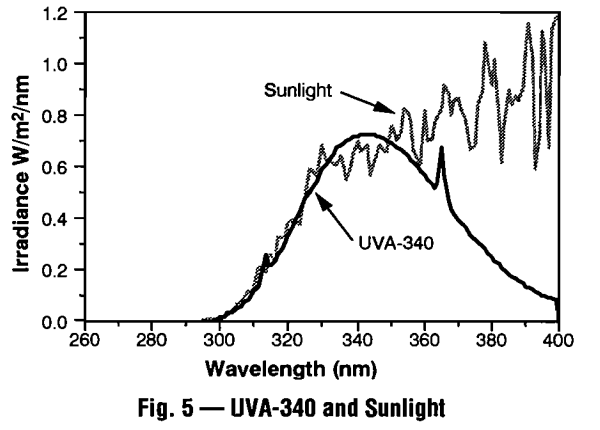
Figure 5 shows the UVA-340 compared to Solar Maximum. This lamp is an excellent simulation of sunlight from about 365 nm, down to the solar cut-off of 295 nm.
QUV IRRADIANCE CONTROL
The QUV uses fluorescent UV lamps to simulate the effects of sunlight. One advantage of fluorescent lamps is their spectral stability throughout their life. In other words, although fluorescent lamps loose output (i.e. brightness) as they age, their spectrum remains essentially the same. This consistency of spectrum allows easier control of irradiance.
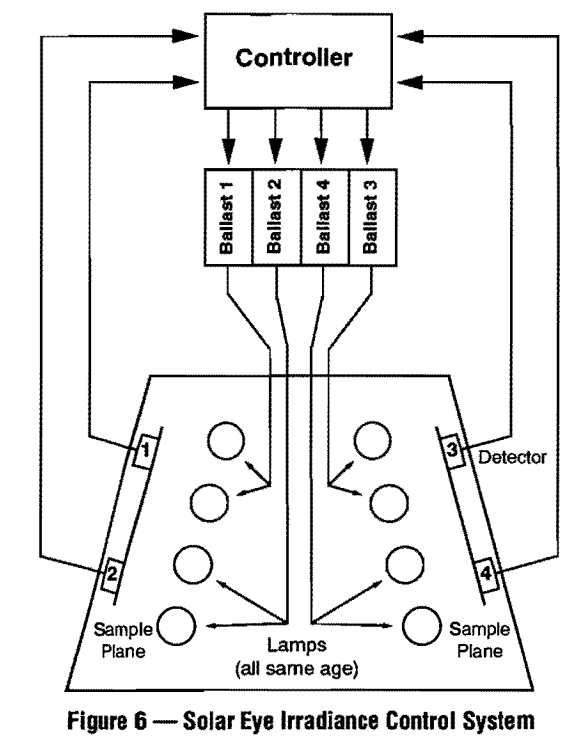
The QUV's Solar Eye irradiance control system (models QUV/se and QUV/spray) consists of a programmable controller that continuously monitors the UV intensity via four sensors mounted in the test sample plane. A four channel feedback loop system maintains the programmed irradiance level by adjusting power to UV lamps. Figure 6 shows a simplified schematic of how the irradiance control system works. With the Solar Eye, the user sets the level of desired irradiance and the Solar Eye maintains it automatically.
Each sensor monitors the intensity of two lamps. Each sensor is individually calibrated by the operator on a regular basis. The calibration is traceable to the U.S. National Institute of Standards and Technology (NIST).
Another advantage of the Solar Eye is that a push-button irradiance setting allows you to fix the exact irradiance level. With the UVA-340 lamp you can operate the Solar Eye at various levels for different applications and still maintain realistic test conditions. For example, as shown in Figure 8, with the UVA-340 lamps you could set the Solar Eye to simulate any of the following sunlight conditions:
- Intensified 75% (higher than QUV/basic) for fast results.
- Typical (equivalent to noon summer sunlight) for quick results without sacrificing correlation. This is the irradiance of a QUV/basic.
- Reduced to .35 W/m2/nm at 340 nm to match so-called "Average Optimum" sunlight or Xenon.
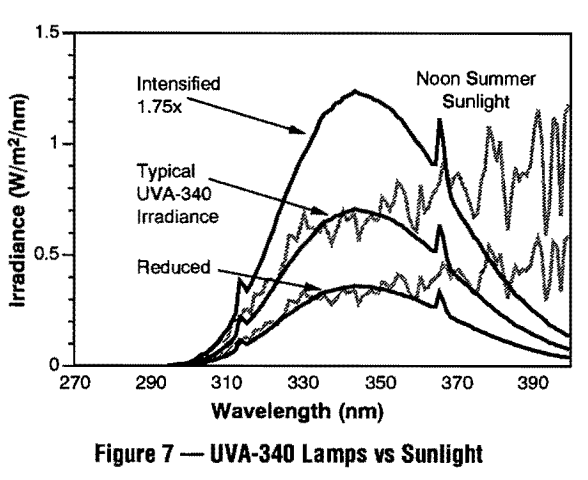
Using UVB-313 lamps, you can operate at Intensified (75% higher than standard) for extremely fast tests, for Quality Control applications, or for testing very durable materials. You can also set the irradiance level to be equivalent to the QFS-40 lamp and reap the benefits of greatly enhanced lamp life. (Figure 8)
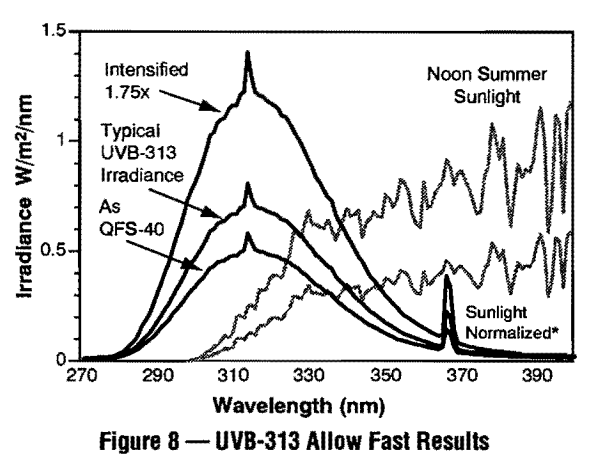
THE QUV/basic AND MANUAL IRRADIANCE CONTROL
The QUV/basic is the original version of the QUV. It is still widely used in labs where economy is critical. It is the same as the QUV/se, but without the automatic Solar Eye irradiance control system. With the QUV/basic irradiance is not adjustable, The QUV/basic compensates for lamp aging by a simple rotation/replacement system.
Rotation System. Each tester uses eight lamps; four on each side. Irradiance is controlled by replacing the oldest lamp in each bank every 400 hours of lamp operation. At that time the remaining six lamps are rotated as shown in Figure 9. The irradiance is an average of lamps at four different points on the age/output curve. This average remains relatively stable over time, giving these multi-lamp testers a substantial advantage over single lamp testers.
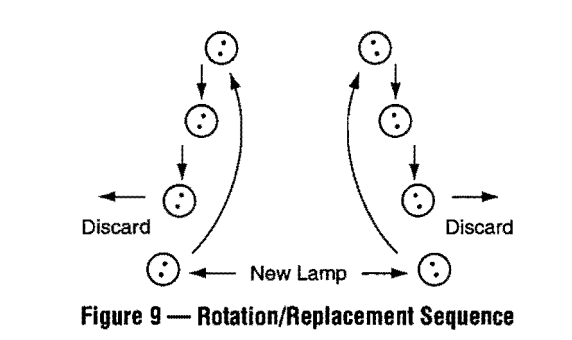
There are two inherent weaknesses in this system. First, there is no way to compensate for any lot to lot differences in lamps from manufacturing limitations. Second, because lamps deteriorate with age, there is a drop in light output between rotations. This is not significant with some lamp types. For Example, UV A-340 output drops only about 5%. However it can be very significant with other lamps. FS-40 lamp output may drop 15%.
MOISTURE SIMULATION
Enclosed Carbon Arc
The carbon arc uses a system of intermittent water spray to simulate the effects of rain and dew. There are several problems with this.
- Distilled or deionized water is necessary to prevent water spotting and contamination of the test specimen.
- Relatively cold water from a reservoir is sprayed on a hot sample. This causes thermal shock and rapid evaporation of the water. Moisture doesn't have time to penetrate the sample.
- Water from the reservoir may be oxygen poor.
QUV Moisture System
The QUV uses condensation for it's moisture cycle. The QUV's condensation cycle is more realistic and more severe than water spray for the following reasons:
- Condensation simulates outdoor moisture attack more realistically than water spray. Most outdoor wetness is caused by dew, not rain. For more information on time of wetness outdoors, see Bulletin LU-0821 , "Know your Enemy: The Weather and How to Reproduce it in the Laboratory."
- The QUV's condensation is at elevated temperature to accelerate moisture effects.
- The QUV allows the moisture several hours to penetrate the test specimen. A typical QUV condensation cycle is 4 hours at 50°C.
- The QUV's condensation assures water purity and oxygen saturation without cumbersome stills or deionizers.
MAINTENANCE
The carbon arc requires daily cleaning and carbon rod replacement. This procedure typically takes over an hour every day. Filters must be cleaned and replaced frequently. In contrast, QUV maintenance requirements are about 5 minutes each month.
The QUV operates automatically over weekends and holidays, 24 hours a day, 7 days a week. This translates into significantly more yearly test time than a carbon arc.
COST CONSIDERATIONS
Purchase Price
The purchase price of a carbon arc is many times higher than that of a QUV.
Operating Costs
Typical operating costs for an enclosed carbon arc in constant use are approximately $5,000 per year. The QUV costs about $1000 per year if used continuously.